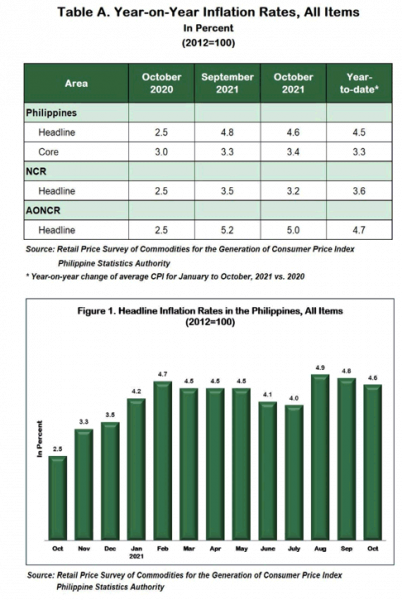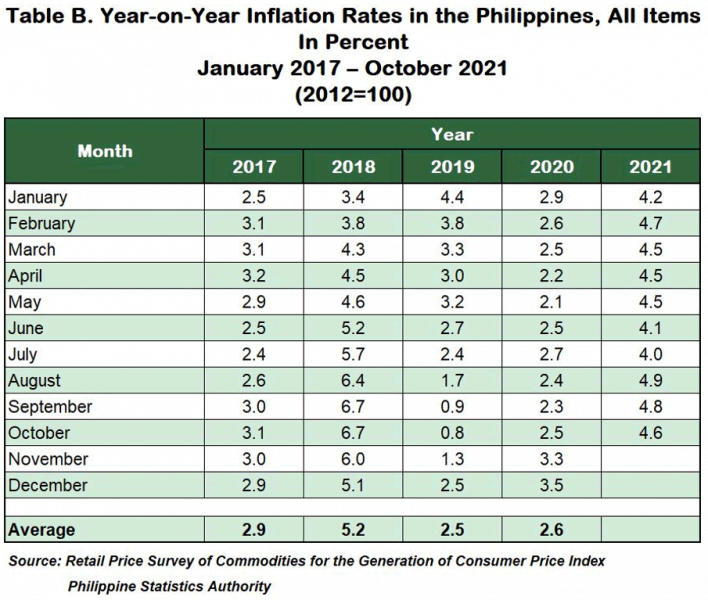1. Philippines

The country’s headline inflation decelerated further to 4.6 percent in October 2021, from 4.8 percent in September 2021. This brings the year-to-date inflation from January to October 2021 at
The main source of the downward trend of the October 2021 inflation was primarily due to the slower annual increment registered in food and non-alcoholic beverages index at 5.3 percent, from
Contributing also to the downward trend in the overall inflation were the lower inflation recorded in the indices of the following commodity groups:
- Alcoholic beverages and tobacco, 9.8 percent;
- Education, 0.7 percent; and
- Restaurant and miscellaneous good and services; 3.8 percent.
On the other hand, inflation rates were higher in the indices of the following commodity groups:
- Housing, water, electricity, gas and other fuels, 4.4 percent;
- Furnishing, household equipment and routine maintenance of the house, 2.5 percent;
- Health, 3.2 percent
- Transport, 7.1 percent; and
- Recreation and culture, 1.0 percent.
The indices for clothing and footwear, and communication retained their previous month’s annual growth rates of 1.9 percent and 0.2 percent, respectively.
Excluding selected food and energy items, core inflation, inched up to 3.4 percent in October 2021, from 3.3 percent in September 2021. In October 2020, core inflation was posted at 3.0 percent. (Tables A and 9)
Inflation for food index at the national level slowed down further to 5.6 percent in October 2021, from 6.5 percent in the September 2021. In October 2020, inflation for food was observed at 2.1 percent. (Table 7)
Annual hikes decelerated during the month in the indices of meat at 11.9 percent; fish, 9.5 percent; and vegetables at 11.4 percent.
Meanwhile, the annual growth rate of fruits index rose to 0.2 percent during the month, after posting an annual decline of -0.4 percent in September 2021. Moreover, the annual rate of rice index went up to 0.5 percent during the month, from a zero percent annual growth in the previous month.
Higher annual increments were also registered in the indices of other food groups during the month, except for the indices of milk, cheese and eggs; and food products not elsewhere classified, which retained their previous month’s annual growth rates of 0.7 percent and 1.9 percent, respectively. (Table 5)

2. National Capital Region (NCR)
Similarly, inflation in NCR slowed down to 3.2 percent in October 2021, from 3.5 percent in September 2021. In October 2020, inflation in the region was noted at 2.5 percent. (Tables A and 3)
The slower pace in the inflation in NCR was mainly due to the lower annual rate of increase in food and non-alcoholic beverages index at 3.4 percent during the month, from 5.2 percent in the previous month. Annual increments also eased in the indices of clothing and footwear at 0.6 percent; and restaurant and miscellaneous goods and services at 2.8 percent.
On the other hand, annual upticks were higher in the indices of housing water electricity, gas and other fuels at 3.1 percent; health, 3.3 percent; and transport at 6.3 percent.
The indices of the rest of the commodity groups either retained their previous month’s rates or had zero percent annual growth during the month. (Tables 3 and 4)
3. Areas Outside NCR (AONCR)
Following the trend of the Philippines and NCR, inflation in AONCR slid to 5.0 percent in October 2021, from 5.2 percent in September 2021. Inflation in AONCR in October 2020 was posted at 2.5 percent. (Tables A and 3)
Inflation in AONCR was primarily pushed down by the lower inflation in food and non-alcoholic beverages index at 5.7 percent in October 2021.
Slower annual increases during the month were also observed in the indices of the following commodity groups:
- Alcoholic beverages and tobacco, 9.7 percent;
- Health, 3.1 percent;
- Education, 0.8 percent; and
- Restaurant and miscellaneous goods and services, 4.1 percent.
On the other hand, higher annual upticks were noted in the indices of the following commodity groups:
- Housing, water, electricity, gas and other fuels, 4.8 percent;
- Furnishing, household equipment and routine maintenance of the house, 2.9 percent;
- Transport, 7.2 percent; and
- Recreation and culture, 1.3 percent.
The indices of other commodity groups such as clothing and footwear, and communication moved at their previous month’s annual growth rates of 2.1 percent and 0.3 percent, respectively. (Tables 3 and 4)
Eight regions in AONCR exhibited lower inflation during the month. Among the regions in AONCR, the lowest inflation was still recorded in Bangsamoro Autonomous Region in Muslim Mindanao (BARMM) at 2.4 percent, while the highest remained in Region V (Bicol Region) at 6.6 percent. (Table 4)
Note: CPIs and inflation rates by province and selected city are posted on the PSA website (http://openstat.psa.gov.ph/).
DENNIS S. MAPA, Ph.D.
Undersecretary
National Statistician and Civil Registrar General
See more at the CPI and Inflation Rate page.
